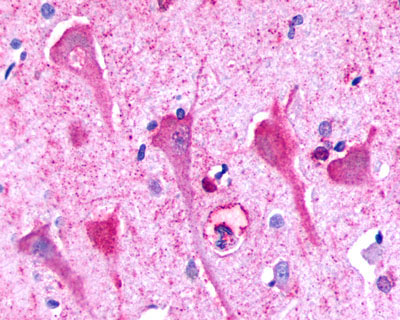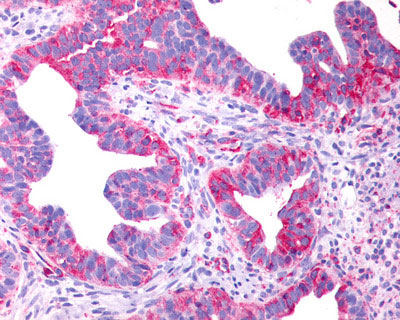P2RY8 / P2Y8 Antibody (Cytoplasmic Domain)
Rabbit Polyclonal Antibody
- SPECIFICATION
- CITATIONS
- PROTOCOLS
- BACKGROUND

Application
| IHC-P |
|---|---|
| Primary Accession | Q86VZ1 |
| Reactivity | Human |
| Host | Rabbit |
| Clonality | Polyclonal |
| Calculated MW | 41kDa |
| Dilution | IHC-P (2-4 µg/ml) |
| Gene ID | 286530 |
|---|---|
| Other Names | P2Y purinoceptor 8, P2Y8, P2RY8 |
| Target/Specificity | Human P2RY8 / P2Y8. BLAST analysis of the peptide immunogen showed no homology with other human proteins, except GPR174 (41%). |
| Reconstitution & Storage | Long term: -70°C; Short term: +4°C |
| Precautions | P2RY8 / P2Y8 Antibody (Cytoplasmic Domain) is for research use only and not for use in diagnostic or therapeutic procedures. |
| Name | P2RY8 {ECO:0000303|PubMed:30842656, ECO:0000312|HGNC:HGNC:15524} |
|---|---|
| Function | G protein-coupled receptor for S-geranylgeranyl-glutathione (GGG), an endogenous metabolite present in lymphoid tissues. Couples the binding of GGG to the activation of GNA13 and downstream repression of AKT activation in lymphocytes defining their positioning and growth within lymphoid organs (PubMed:25274307, PubMed:30842656, PubMed:34088745). In lymphoid follicles, confines B cells and follicular helper T cells in germinal centers (GCs) in response to GGG local gradients established by GGT5 (via GGG catabolism) and ABCC1 (via extracellular transport) with lower concentrations of GGG found in the follicular dendritic cell network region around which germinal centers are formed (PubMed:25274307, PubMed:30842656, PubMed:34088745). In the bone marrow, also in response to GGG gradients established by GGT5 and ABCC1, it restricts chemotactic transmigration of B cells, T cells and NK cells from blood vessels to the bone marrow parenchyma (PubMed:30842656, PubMed:34088745). Contributes to GNA13-dependent pathway that suppresses GC B cell growth (PubMed:25274307). |
| Cellular Location | Cell membrane; Multi-pass membrane protein |
| Tissue Location | Barely detectable in normal blood leukocytes. Weaker expression was seen in heart, kidney and lung. Not detected in brain (PubMed:11004484, PubMed:15466006). Expressed in B cells and follicular helper T cells in germinal centers (at protein level) (PubMed:30842656). |
| Volume | 50 µl |

Thousands of laboratories across the world have published research that depended on the performance of antibodies from Abcepta to advance their research. Check out links to articles that cite our products in major peer-reviewed journals, organized by research category.
info@abcepta.com, and receive a free "I Love Antibodies" mug.
Provided below are standard protocols that you may find useful for product applications.
Background
Probable receptor for purines coupled to G-proteins.
References
Ross M.T.,et al.Nature 434:325-337(2005).
Adrian K.,et al.Biochim. Biophys. Acta 1492:127-138(2000).
Cantagrel V.,et al.J. Med. Genet. 41:736-742(2004).
Wollscheid B.,et al.Nat. Biotechnol. 27:378-386(2009).
If you have used an Abcepta product and would like to share how it has performed, please click on the "Submit Review" button and provide the requested information. Our staff will examine and post your review and contact you if needed.
If you have any additional inquiries please email technical services at tech@abcepta.com.













 Foundational characteristics of cancer include proliferation, angiogenesis, migration, evasion of apoptosis, and cellular immortality. Find key markers for these cellular processes and antibodies to detect them.
Foundational characteristics of cancer include proliferation, angiogenesis, migration, evasion of apoptosis, and cellular immortality. Find key markers for these cellular processes and antibodies to detect them. The SUMOplot™ Analysis Program predicts and scores sumoylation sites in your protein. SUMOylation is a post-translational modification involved in various cellular processes, such as nuclear-cytosolic transport, transcriptional regulation, apoptosis, protein stability, response to stress, and progression through the cell cycle.
The SUMOplot™ Analysis Program predicts and scores sumoylation sites in your protein. SUMOylation is a post-translational modification involved in various cellular processes, such as nuclear-cytosolic transport, transcriptional regulation, apoptosis, protein stability, response to stress, and progression through the cell cycle. The Autophagy Receptor Motif Plotter predicts and scores autophagy receptor binding sites in your protein. Identifying proteins connected to this pathway is critical to understanding the role of autophagy in physiological as well as pathological processes such as development, differentiation, neurodegenerative diseases, stress, infection, and cancer.
The Autophagy Receptor Motif Plotter predicts and scores autophagy receptor binding sites in your protein. Identifying proteins connected to this pathway is critical to understanding the role of autophagy in physiological as well as pathological processes such as development, differentiation, neurodegenerative diseases, stress, infection, and cancer.



